Earlier today, Panasonic released the official technical specifications for their upcoming AU-EVA1 5.7K camera.
The Panasonic AU-EVA1 has a suggest list price of $7,495 US, £6,120 + VAT (UK) and €7,290 (EU). Keep in mind that those are list prices, which means some resellers will be selling either at list or below, therefore expect slight variations. Given the popularity of this camera among the filmmaking community, I won’t be surprised to see street prices around $7K US at some point through some more aggressive resellers.
Reputable official resellers such as B&H are listing the camera available to pre-order for $7,345. The camera is expected to start shipping sometime in the Fall, however a more concrete time frame has not been given. Sadly, Panasonic have not yet released any footage from the EVA1, even though this I am sure is coming in the upcoming weeks (or maybe even days).
The EVA1 was recently spotted in Iceland, in the hands of some very talented people, who are apparently shooting the first official promo for the camera. Check out our previous post on this here.
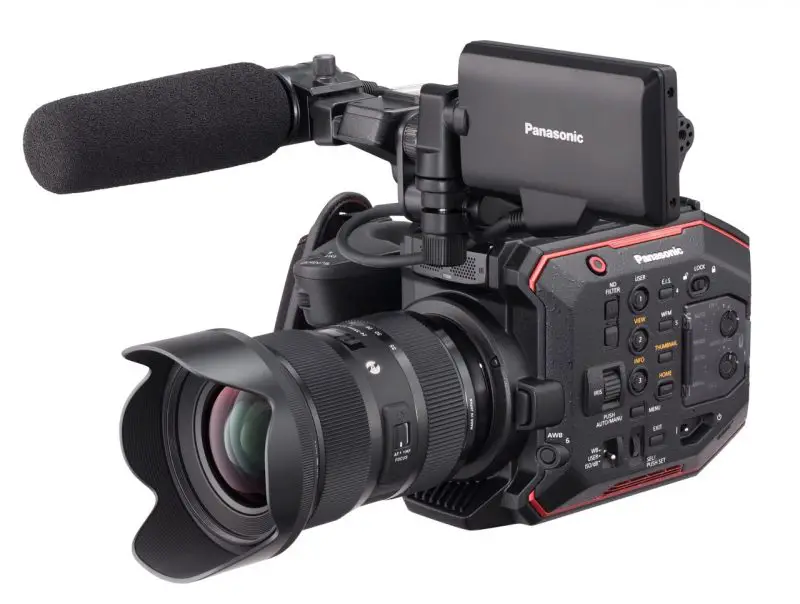
Panasonic AU-EVA1 Highlights Features:
- NEW Super 35mm 5.7K Sensor
- Effective 17.25 MP, 5720 x 3016
- 5.7K Raw output (10bit)- will be a future update (unclear if free or paid)
- Atomos have announced support for 5.7K Raw.
- Dual Native ISO 800/2,500
- 800 Base: 200 to 2,000
- 2,500 Base: 1,000 to 25,600
- Built-in ND – 2, 4, 6 stops
- IR Cut filter – slides out of path by pressing button
- Both IR and ND can be controlled remotely via App
- Electric Image Stabilization (EIS)
- One-Push AF (no mention of Continuous AF?)
- Canon EF Lens Mount (permanent)
- 4K and UHD Recording:
- 50/60 fps is 8bit 4:2:0 LongGOP at 150Mbps
- 4K 10bit 4:2:2 Intra 400 Mbps (VBR) at 30p, 24p, 25p (future firmware)
- 4K 10bit 4:2:2 LongGOP 150Mbps 30p, 24p, 25p
- 2K and Full HD
- 2K/240 fps (sensor crop – 4/3″ size)
- 2K/120fps – uses Full S35 sensor
- Dual SD Card slots – USH-II/V90 supported
- V-Log and V-Gamut
- Hybrid Log Gamma
- 14 stops dynamic range
- 3.5-type LCD touchscreen monitor
- Imaging Tools:
- Peaking, Expand (Image Zoom),
- Waveform, Zebras, and Spotmeter (Y-Get).
- Green Focus Squares (from Varicam LT – really useful tool)
- No Built-in EVF
- SDI and HDMI both can output 4K/60p
- Battery (same as on the Panasonic DVX200):
- AG-VBR59 (supplied) 7.28 V 5900 mAh /43 Wh – $185 at B&H
- Charge time: 3 hour 20 min
- Price: $7,345 (B&H, Adorama)
- Availability: Fall 2017
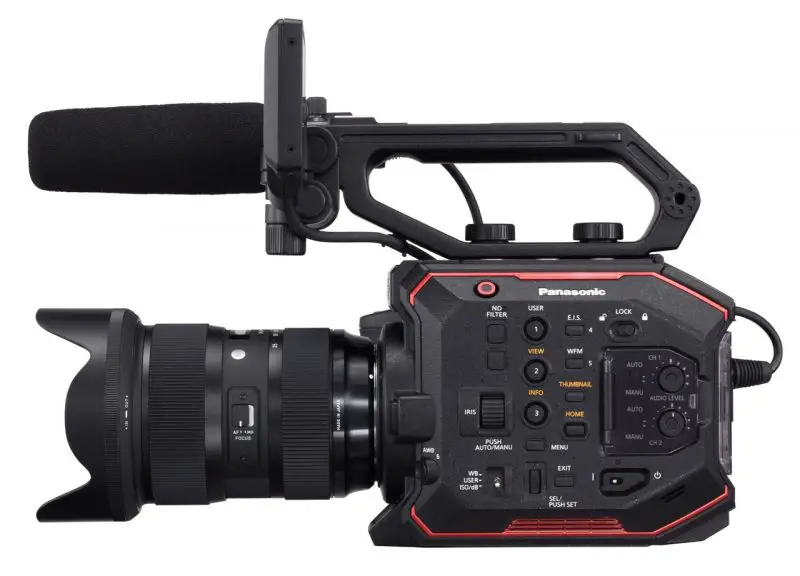
Panasonic EVA1 Official Specs
Recording Resolutions:
- 4096 x 2160 (4K)
- 23.98/24/29.97/25/50/60p
- 3840 x 2160 (UHD)
- 23.98/24/29.97/25/50/60p
- 2048 x 1080 (2K)
- up to 120/240fps
- 1920 x 1080 (FHD)
- 1280 x 720 (HD)
Card Slot Functions:
- Simul Rec / Relay Rec
- Loop Rec Background Rec
- Pre Rec / Interval Rec / One Shot Rec
Power / Operation:
- DC 7.28 V (Battery Operation)
- DC 12 V (AC adapter operation)
- Power Consumption: 19 W (with LCD/HDMI/SDI ON)
- Operating Temperature: 0 °C to 40 °C (32°F to 104°F)
- Operating Humidity: 10% to 85% (relative humidity)
- Storage Temperature: –20 °C to 60 °C (–4°F to 140°F)
Weight:
- Body: Approx. 1.2 kg (2.65 lb) (excluding accessories)
- Shooting: Approx. 2.05 kg (4.52 lb) (with accessories)
Dimensions:
- 135 mm (W) x 133 mm (H) x 170 mm (W)
- (5-5/16 inches x 5-1/4 inches x 6-11/16 inches)
Digital Audio:
- MOV: 48 kHz/24 bit, 2 CH, Linear PCM
- AVCHD: 48 kHz/16 bit, 2 CH, Dolby Audio
- Headroom: 18 dB/20 dB (menu switchable)
VIDEO OUT:
6G-SDI Output format (4:2:2 10 bit):
- 4096 x 2160:
- 29.97p, 25p, 24p, 23.98p
- 3840 x 2160:
- 29.97p, 25p, 24p, 23.98p
- 1920 x 1080:
- 59.94p, 50p, 59.94i, 50i,
- 29.97p, 29.97PsF, 25p, 25PsF,
- 24p, 24PsF, 23.98p, 23.98PsF
- 1280 x 720p:
- 59.94p, 50p
Raw output format (10 bit) SDI ONLY:
- 5,760 x 3,072: 29.97p, 25p, 24p, 23.98p
- 4,096 x 2,160: 59.94p, 50p, 29.97p, 25p, 24p, 23.98p
HDMI Output format (4:2:2 10 bit):
- 4096 x 2160:
- 59.94p, 50p, 29.97p, 25p, 24p, 23.98p
- 3840 x 2160:
- 59.94p, 50p, 29.97p, 25p, 24p, 23.98p
- 1920 x 1080:
- 59.94p, 50p, 59.94i, 50i, 29.97p, 25p, 24p, 23.98p
- 1280 x 720:
- 59.94p, 50p
- 720 x 480:
- 59.94p
- 720 x 576: 50p
Output format (4:2:0 8 bit):
- 4096 x 2160: 59.94p, 50p
- 3840 x 2160: 59.94p, 50p
Supplied Accessories:
- Battery (5900 mAh)
- Battery charger
- AC adapter, AC cable
- Shoulder strap
- Microphone holder, Microphone holder adapter
- LCD monitor (with hood and mounting attachment)
- Handle, Grip, Grip belt, Mount cap
Download the Full EVA1 Specs in PDF by clicking here.
Here is what the back of the Panasonic AU-EVA1 looks like:
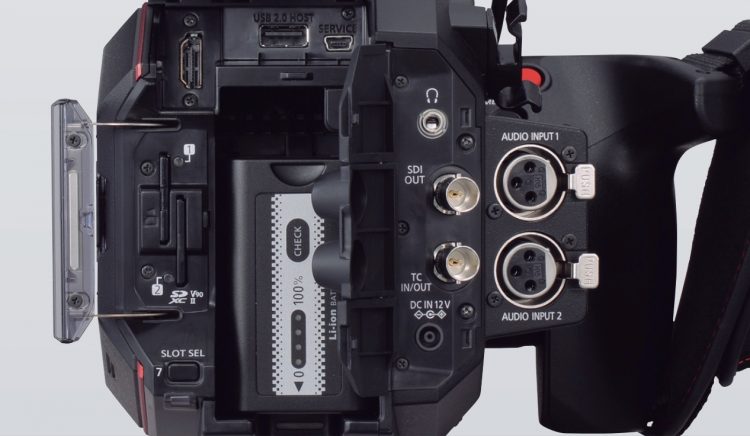
The EVA1 is clearly positioned right against the Canon EOS C200, both in terms of pricing and features (despite some key features being quite different); both cameras are priced in the mid-$7K range, with the C200 having internal 12bit and 10bit 4K Raw and the lovely Dual-Pixel AF, while recording to more expensive media such as Cfast 2.0 cards, while the EVA1 keeps the media cost lower with SDXC USH-II cards, however missing continuous AF and internal Raw.
The key features of the EVA1 are of course the 10bit 422 Intra recording (internally), which won’t be available at launch, but rather as a firmware update in the near future. The 5.7K Raw is only 10bit according to the press release and specs, so that’s a bit of a bummer, but until we see actual footage and get a chance to play with the Raw files, it can be “game-changing” (for the record, I hate that word) for all I know.
For me, personally, the EVA1 is not of a purchase interest, (but a rental – oh, hell yeah) purely because I already bought a Canon C300 Mark II and a Canon 5D mark IV, so I have zero money left. It was a decision made long time ago based on many factors – but mainly vertical integration with existing workflow including – lens selections, Movie Servo AF availability and the fact that I work frequently with a few photographers who are Canon junkies and we often need a 2nd or 3rd 5D so that’s that.
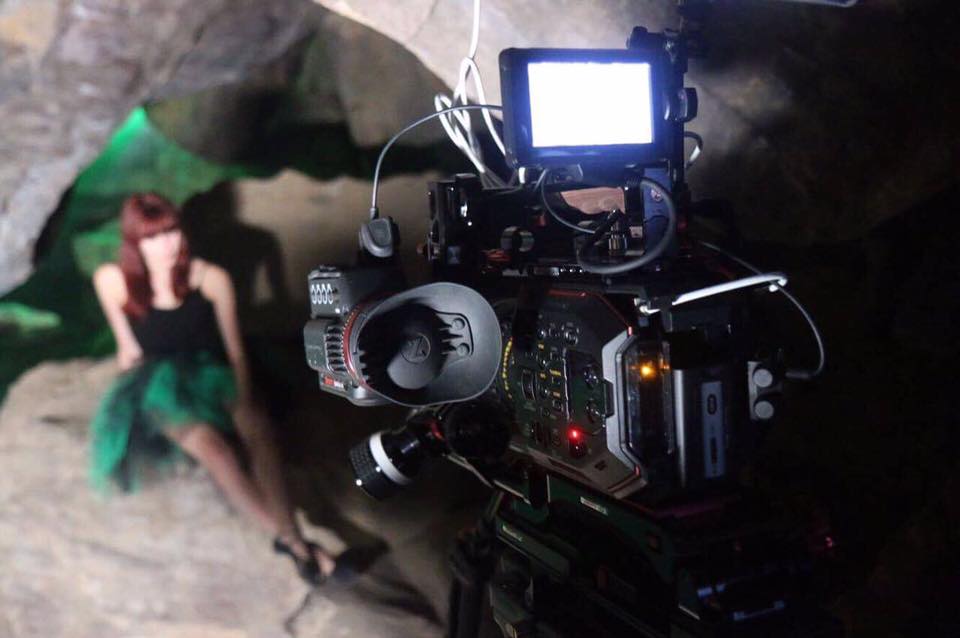
Image provided by Panasonic
However, for a lot of you out there with some decent change in your pockets (about 7 grand of it) the EVA1 should be on top of your list of cameras to consider. I commend Panasonic for breaking offering a 4K 10bit 4:2:2 Intra codec (at least as a future firmware) in a camera that costs less than 8 grand. This is sort of a first come to think of it. You also get 4K/60p – not in 10bit, but still it’s there.
In Summary, this is what I think about the Panasonic EVA1 Specs Launch:
Thumbs Up for:
- 4K 10bit 4:2:2 internal
- Records onto SDXC cards
- 2K/120fps – full S35 readout
- Dual ISO
- IR Cut sliders out of image path with a button
- Compact form factor
- Green Squares Focus dealio from the Vari LT – killer feature.
- Competitive price.
Thumbs Down for:
- No continuous AF – a bit of a missed opportunity with the EF mount
- No touchscreen support for AF – has to be done through a side button
- 400 MBps 10bit 4K is a future update
- Dual ISO – top end Base only 2500 (that’s only 1.5 stops from 800)
- Too much hype – no footage yet – better be shockingly good or else, maybe bust!
- 5.7K Raw output is only 10bit (and a future update) plus you need an external recorder and media, that’s another 2 grand
- No built-in EVF
But that’s just me – what do you guys think about the EVA1 price and specs? Share in the comments below, and keep it lady and gentleman-like please. Cheers,
Pre-order links:
PRESS RELEASE
Panasonic today disclosed additional information, including pricing and specification data, about the upcoming AU-EVA1 5.7K handheld cinema camera. Previewed this spring at Cine Gear Expo, the EVA1 will ship this autumn with a suggested list price of €7,290. Technical specifications now include a pixel count of 5720 H x 3016 V (17.25 million), confirmed dual native ISO ratings of 800 and 2,500, and 14-stops of dynamic range.
“The EVA1’s 5.7K Super-35 sensor has almost twice as many photosites as 4K,” noted Luc Bara, Technical Product Manager for Panasonic. “That means the 4K videos recorded in the camera will be crystal clear with rich colour information. The EVA1 also inherits the unique dual native ISO sensor technology from our cinema VariCam line, allowing it to shoot in bright sunlight or night exteriors without compromising the image quality. And the 14 stops of dynamic range capture a huge scope of exposure detail.”
The newly-designed EVA1 sensor is Super-35 sized (24.60mm x 12.97mm) with 5.7K resolution. With an active resolution of 5720 x 3016, the EVA1 delivers more than 17.25 million photosites, nearly double the 8.8 million for 4K DCI (4096 x 2160). By starting at a higher native resolution, the 5.7K sensor yields a higher resolving image when down-sampled to 4K, UHD, 2K, or even 720p. Additionally, the increased colour information results in a finer, more accurate finished image.
A key feature of the VariCam cameras, dual native ISO utilises a process that allows the sensor to be read in a fundamentally different way, extracting more information without degrading the image. This results in a camera that can switch from a standard sensitivity to a high sensitivity with almost no increase in noise or other artefacts. Dual native ISO has allowed cinematographers a greater variety of artistic choices as well as the ability to use less light on set, saving time and money. The EVA1’s dual native ISOs are 800 and 2,500, which will allow cinematographers to shoot in almost any lighting environment.
The EVA1 delivers 14-stops of dynamic range, enabling fine gradation in exposure from bright to dark. The ability to capture accurate colours and rich skin tones is a must for any filmmaker. The EVA1 features full V-Log/V-Gamut capture to best utilise high dynamic range and broad colours. VLog has log curve characteristics that is HDR ready and V-Gamut delivers a colour space that will cover BT.2020.
Weighing only 1.2Kg (body-only) with a compact form factor (17cm H x 13.5cm W x 13.3cm D) and a removable handgrip, the EVA1 can be used for efficient handheld shooting applications. Because of its compact form factor, it can also be mounted on a drone, gimbal rig or jib arm for complex yet smooth camera moves. There will also be numerous mounting points and Panasonic is currently working with top accessory makers to allow further customisation with the EVA1.
The included adjustable handgrip offers several controls, including Menu, REC start/stop, Iris and Two User Buttons.
The EVA1’s LCD screen is a 3.5” touch panel for menu selections, expand (image zoom) positioning and playback controls. The LCD has an adjustable backlight control, including a Power LCD mode for bright viewing conditions. For lensing, the camera utilises a native EF-mount, giving shooters access to the broad EF lens ecosystem, including dozens of cinema style prime and zoom lenses from numerous manufacturers.
Electronic Image Stabilisation (EIS) within the camera will counterbalance camera shake and blurring, enabling smooth movement for handheld shooting. There will also be full Iris Control, OnePush Auto Focus, and Lens Data. Behind the lens mount, an integrated ND filter wheel in 2, 4, and 6 stops allows for precise exposure control. The EVA1 also allows the IR Cut to be swung out of the path to the sensor at the push of a button. Unique photographic effects and night vision imagery are possible with this control over infrared.
The ND filter and IR Cut filter operate electronically, allowing wireless remote control from smartphones and tablets. EVA1 will have a remote control app for a tablet (iOS, Android) that enables users to control an EVA1 when the camera is on a camera crane, or remote location. Ideal for indie filmmakers, the EVA1 records to readily-available, lower-cost SD cards. With two SD card slots, you can capture footage either with simul rec (simultaneous dual record) or relay rec (continuous record). There’s also one shot record, which enables single frame video for stop motion capture.
The camera can record in several formats and compression rates, and offers up to 10-bit 4:2:2 even in 4K. For in camera recording, you can capture in 4K (4096 x 2160), UHD (3840 x 2160), 2K (2048 x 1080), Full HD (1920 x 1080), and HD (1280 x 720). In a future firmware upgrade, EVA1 will offer ALL Intra compression for in camera recording and 5.7K RAW output to third party recorders.
For high-speed capture, the EVA1 offers up to 59.94fps/50fps for 4K/UHD, up to 120fps/100fps for 2K/Full HD, or 240fps/200fps (cropped area). On first release, available bit rates will range from as low as 8Mbps up to 150Mbps, depending on frame rate, resolution, and codec. In a future firmware update, 400Mbps recording will be added. As a professional video production tool, EVA1 contains several professional imaging tools, including peaking, expand (Image Zoom), waveform, zebras, and spotmeter (Y-Get).
EVA1 also utilises focus squares, an array of green squares that grow in size when their local area appears to be sharp, to enable shooters to achieve critical focus. EVA1 offers dual balanced XLR audio inputs with Dolby AudioTM encoding. The HDMI and SDI video outputs are both 4K-capable and each can be adjusted separately, allowing HD to be fed to a viewfinder or other third party monitor while 4K is sent to an outboard recorder or monitor. The camera is also equipped with standard TimeCode functionality.
For more information about the AU-EVA1, visit Panasonic.
Disclaimer: As an Amazon Associate partner and participant in B&H and Adorama Affiliate programmes, we earn a small comission from each purchase made through the affiliate links listed above at no additional cost to you.


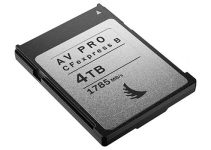
I was honestly a bit shocked by 4K 60fps only in 4:2:0 8 bit, in fact, when it comes to actual image quality, not seeing enough reasons for someone to get this over a GH5 with speedbooster. Hopefully more interesting info will come out to convince potential buyers like dynamic range and highlight rolloff being mind-blowingly good. To be continued indeed.
This was to be expected given where the camera sits in the hierarchy. For some it’s a big deal, for others not so much.
Compared to a GH5, your paying for ergonomics, a real video camera with on-board sound(not an add-on box), solid video outs and TC, ect. You can always rig up a DSLR using accessories and work arounds to be a video camera, with equal results image quality wise, but it’s never quite the same. As capable as a GH5 is, it’s not just about the end result. Depends on your background and expectations and perception of some clients. It comes down to the day in day out challenges you face. For many, DSLRs fit the bill. For many, they’re just not enough.
I have an A7s and and FS5. The A7s I would argue has better image quality but I use the FS5 way more often and find it better value despite the extra cost. The dual card slots, battery life, variable ND, XLR inputs, ergonomics, etc. The sensor and codecs are almost an after thought.
“Given the popularity of this camera among the filmmaking community, I
won’t be surprised to see street prices around $7K US at some point
through some more aggressive resellers.”
Can’t be ‘popular’ until AFTER it’s release.
There can be great interest in it, but popularity is a reflection of the respect it earns, and the sales it makes, so if can’t be popular until it’s shipped.
When I wrote that, I knew there’d be someone who would make that exact same comment. Sure, you win the Internet. Congrats.
Cool, so you recognise it’s important for articles like this to be factually correct.
Now, if only the guys at Cinema5D would follow that example.
“Cool, so you recognise it’s important for articles like this to be factually correct.”
There was nothing factually incorrect in the article. Just because you disagree with my interpretation of the concept of popularity, does not make such interpretation incorrect.